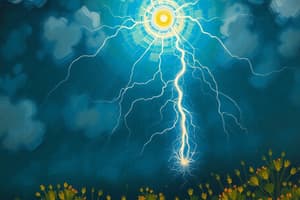Podcast
Questions and Answers
What is electricity?
What is electricity?
A phenomenon associated with the presence and motion of electrons and other charged particles.
What is electric current?
What is electric current?
The directional motion of electrons.
What does electrostatics deal with?
What does electrostatics deal with?
Stationary charged particles.
What is magnetism?
What is magnetism?
What is electromagnetism?
What is electromagnetism?
Who discovered the electron and when?
Who discovered the electron and when?
Which particle is negatively charged?
Which particle is negatively charged?
What is the mass of a proton compared to that of an electron?
What is the mass of a proton compared to that of an electron?
What is an atom?
What is an atom?
What defines an element?
What defines an element?
What is a compound?
What is a compound?
What is a valence electron?
What is a valence electron?
Which of the following is a material that allows electrical current to flow easily?
Which of the following is a material that allows electrical current to flow easily?
How many valence electrons does an insulator typically have?
How many valence electrons does an insulator typically have?
A _____ is a material with exactly four valence electrons.
A _____ is a material with exactly four valence electrons.
What is the energy gap?
What is the energy gap?
What is a coulomb?
What is a coulomb?
Protons carry a negative charge.
Protons carry a negative charge.
Flashcards are hidden until you start studying
Study Notes
Electricity
- Phenomenon associated with presence and motion of charged particles
- Includes electrons and other charged particles
Electric Current
- Directional motion of electrons
Electrostatics
- Deals with stationary charged particles
Magnetism
- Effect of moving electrons
Electromagnetism
- Magnetism due to electric current
Atomic Structure
- Electrons, protons, and neutrons are the main components
- J.J Thomson discovered the electron in 1897, initially called corpuscles
Elementary Particles
- Electrons are negatively charged
- Protons are positively charged
- Neutrons are electrically neutral
- Proton mass is 1836 times the mass of an electron
Structure of Matter
- Matter is anything in the universe that has mass, occupies space, and can be converted to energy
- Atoms are the basic building blocks of matter, made of electrons, protons, and neutrons
- Atoms combine to form elements or compounds
Structure of Matter - Elements and Compounds
- Elements are substances made of only one type of atom
- Compounds are combinations of two or more different atoms or elements
Structure of Matter - Molecules and Atomic Numbers
- A molecule is the smallest part of a compound or material that retains the compound's properties
- Atomic number determines the number of protons in an atom's nucleus, which equals the number of electrons in a neutral atom
- The atomic number determines an element's position within the periodic table
Bohr Atomic Model
- Developed by Niels Bohr in 1913
- Maximum electrons in a shell (nth shell) can be approximated by n²
- Energy levels increase as electrons move further away from the nucleus
Bohr Atomic Model - Valence Shells and Electrons
- Valence shell: outermost shell of an atom
- Valence electrons occupy the valence shell
- Free electrons are valence electrons that gain energy and escape the valence shell
Electrical Classifications of Materials
- Number of valence electrons dictates a material's electrical characteristics
Conductors
- Less than four valence electrons, allowing electrical current to flow easily due to many free electrons
Insulators
- More than four valence electrons, hindering electrical current flow due to very few or no free electrons
Semiconductors
- Four valence electrons, with electrical characteristics between conductors and insulators
Energy Bands
- Valence electrons require energy to escape their shell and become free
- Energy gap is the energy difference between the valence band and conduction band, measured in electron volts (eV)
Valence Band
- Region occupied by valence electrons and the valence shell, representing the highest energy level before the conduction band.
Conduction Band
- Region where free electrons exist, having higher energy levels than valence electrons
Forbidden Band
- Region where no electrons exist, between allowed bands like the valence and conduction bands.
Electron Volt
- Unit of energy equal to the energy gained by an electron when moving from a low potential point to a point one volt higher
Energy Gap of Different Materials
- Conductors have small energy gaps, allowing valence electrons to easily become free. This explains their high number of free electrons and ability to easily support electric current flow.
Studying That Suits You
Use AI to generate personalized quizzes and flashcards to suit your learning preferences.




